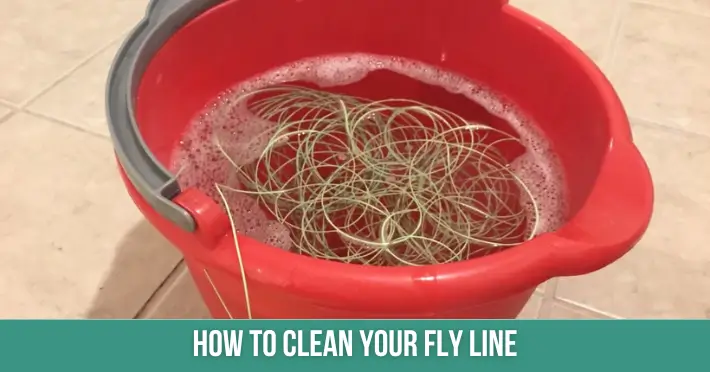Contents
- 1 How To Clean Your Fly Line:
- 2 Preparing for Cleaning:
- 3 Strip line from the reel:
- 4 Inspect for any visible damage:
- 5 Wipe down with a damp cloth:
- 6 Conclusion:
- 7 FAQs:
- 8 Q1: How often should I clean my fly line?
- 9 Q2: Can I use regular soap to clean my fly line?
- 10 Q3: What’s the purpose of fly line dressing?
- 11 Q4: Should I clean my fly line if I fish in freshwater only?
- 12 Q5: Can I clean my fly line while it’s still on the reel?
- 13 Q6: How do I store my fly line between fishing trips?
- 14 Q7: Can I use any cloth to wipe down my flyline?
- 15 Q8: How do I know if my fly line needs replacement?
To clean your fly line, follow these simple steps. Start by stripping the line off the reel and wiping it down with a damp cloth to remove surface dirt. Next, use a mild soap or specialized fly line cleaner to scrub the line gently. Rinse it thoroughly with fresh water and dry it with a clean cloth.
Finally, apply a fly line dressing to enhance performance and protect against the elements. Regular cleaning will maintain the line’s performance and longevity on the water.
How To Clean Your Fly Line:

Optimal Casting Performance: Over time, dirt, debris, and contaminants accumulate on the fly line, affecting its smoothness and casting performance. Regular cleaning ensures that the line remains supple and moves through the guides smoothly, allowing for more accurate and efficient casts.
Increased Line Lifespan: Dirt and grime can cause abrasion and wear on the fly line. Cleaning removes these particles, reducing friction and extending the lifespan of the line. A well-maintained fly line is less prone to cracking, splitting, or becoming brittle.
Floatation and Buoyancy: Fly lines often have special coatings that provide buoyancy and help them float on the water’s surface. Accumulated dirt can compromise these coatings, making the line sink or absorb water. Cleaning preserves the buoyancy of the line, ensuring it remains on the water’s surface as intended.
Preservation of Line Coating: Many fly lines come with coatings that improve performance, such as slick or textured finishes. Cleaning prevents the buildup of contaminants that can degrade these coatings, preserving the line’s integrity and functionality.
Fly Line Memory: Fly lines can develop memory coils after extended use, affecting their ability to lie straight on the water. Cleaning and properly storing the line help reduce memory coils, maintaining a more natural presentation of flies.
Sensitivity and Line Control: A clean fly line enhances sensitivity, allowing anglers to better feel subtle strikes and movements underwater. It also improves line control, facilitating mending and manipulation for effective fly presentation.
Prevention of Corrosion: If you’re fishing in saltwater environments, salt can corrode the line over time. Cleaning removes salt deposits, preventing corrosion and preserving the structural integrity of the flyline.
In conclusion, regular cleaning is essential for maintaining the performance, buoyancy, and overall condition of your fly line. It not only improves casting efficiency but also extends the life of your equipment, ensuring an enjoyable and successful fishing experience.
Preparing for Cleaning:

Before diving into the process of cleaning your fly line, proper preparation is key to ensuring a thorough and effective cleaning session. Begin by gathering the necessary materials, such as a damp cloth, mild soap or specialized fly line cleaner, and a clean dry cloth for drying.
Take the opportunity to strip the line off the reel, allowing you to inspect it for any visible damage that may require attention.
This initial assessment ensures that you address any potential issues and provides a clean canvas for the cleaning process. Additionally, by being organized and having all the required tools at hand, you streamline the cleaning procedure, making it more efficient and convenient.
Overall, taking a few moments to prepare adequately sets the stage for a successful fly line cleaning, promoting optimal performance and longevity for your equipment.
Strip line from the reel:
Stripping the fly line from the reel is a crucial step in preparing for cleaning. Begin by releasing enough lines from the reel to allow easy access for cleaning the entire length. As you do this, inspect the line for any knots, tangles, or signs of wear.
Smoothly pull the line through your fingers, checking for any rough spots or abrasions that might have developed during use.
Once the line is free from the reel, lay it out in a straight line on a clean surface. This not only facilitates the cleaning process but also allows for a comprehensive inspection of the entire length. Look for any nicks, cuts, or other visible damage that may have occurred during your last fishing trip.
By carefully stripping the line and examining it closely, you ensure that the cleaning process addresses any specific areas of concern. This proactive approach contributes to maintaining the overall health and performance of your fly line, enhancing your fishing experience on the water.
Inspect for any visible damage:
After stripping the fly line from the reel, take a moment to inspect it for any visible damage. Carefully examine the entire length of the line, paying attention to details that might affect its performance. Look for:
Nicks and Cuts: Check for any nicks, cuts, or abrasions on the surface of the line. These can compromise the line’s integrity and affect its strength.
Cracks or Splits: Inspect the line for any signs of cracking or splitting, especially in areas exposed to frequent bending or stress. Cracks can lead to water absorption and reduced buoyancy.
Knots and Tangles: Untangle any knots or tangles in the line that may have formed during use. Ensure the line is free of any loops or twists that could impact casting.
Color Fading: Look for any significant fading or discoloration, as this could indicate sun damage. Prolonged exposure to sunlight can weaken the line’s structure.
Memory Coils: Check for memory coils, which are loops or curls that may have developed from the line being wound on the reel for an extended period. Straighten out any memory coils to ensure a smooth and straight presentation on the water.
Addressing these issues before cleaning allows you to address specific concerns and ensure that the cleaning process is not only effective but also contributes to the overall maintenance of the fly line.
Taking the time to inspect for visible damage helps identify potential problems early on, preventing further deterioration and ensuring optimal performance during your next fishing adventure.
Wipe down with a damp cloth:
After inspecting the fly line for visible damage, the next step in the cleaning process is to wipe it down with a damp cloth. This simple yet crucial step helps remove surface dirt, salt, and other contaminants that may have accumulated during your fishing trips. Here’s how to effectively wipe down your fly line:
Dampen the Cloth: Moisten a clean, soft cloth with fresh water. Avoid using any harsh chemicals or abrasive materials that could potentially damage the line.
Hold the Line Taut: With one hand, hold the fly line taut, preferably between your fingers or through a cloth, to provide resistance while wiping.
Wipe Along the Length: Gently run the damp cloth along the entire length of the fly line.
Apply light pressure to lift away dirt and debris. Pay extra attention to any areas where you noticed visible damage during the inspection.
Repeat as Needed: Depending on the level of dirt, you may need to repeat the wiping process. If the cloth becomes too dirty, rinse it and continue until the entire line is clean.
Dry the Line: After wiping, allow the fly line to air-dry completely before moving on to the next steps. Ensure that there is no residual moisture, as a dry line is essential for optimal performance.
Wiping down the fly line with a damp cloth is a quick and effective way to maintain its cleanliness. This initial cleaning step sets the foundation for deeper cleaning processes and ensures that the line is ready for the application of specialized cleaners and dressings that follow.
Conclusion:
In conclusion, regularly cleaning your fly line is a simple yet essential practice that significantly contributes to its overall performance and longevity. By incorporating a cleaning routine into your maintenance regimen, you enhance casting efficiency, maintain buoyancy, and prevent premature wear and tear.
Proper care not only preserves the structural integrity of the line but also ensures a more enjoyable and successful fishing experience. Taking a few minutes to inspect, wipe down, and apply appropriate treatments will pay off in the long run, keeping your fly line in top condition for countless fishing adventures.
FAQs:
Q1: How often should I clean my fly line?
A1: It’s recommended to clean your fly line after every few fishing outings or whenever you notice a decrease in performance. Regular cleaning helps maintain casting efficiency and prolongs the life of the line.
Q2: Can I use regular soap to clean my fly line?
A2: While mild soap can be used, it’s better to use a specialized fly line cleaner designed to remove dirt, salt, and contaminants without damaging the line’s coating.
Q3: What’s the purpose of fly line dressing?
A3: Fly line dressing enhances the line’s performance by restoring slickness and providing protection against the elements. It also helps increase buoyancy and reduces friction during casting.
Q4: Should I clean my fly line if I fish in freshwater only?
A4: Yes, even in freshwater, your fly line can accumulate dirt and debris, affecting its performance. Regular cleaning is recommended regardless of the type of water you fish in.
Q5: Can I clean my fly line while it’s still on the reel?
A5: It’s best to strip the line from the reel for a thorough cleaning. This allows you to inspect the entire length, addressing any visible damage and ensuring a more effective cleaning process.
Q6: How do I store my fly line between fishing trips?
A6: Store your fly line in a cool, dry place, away from direct sunlight. Avoid leaving it on the reel for extended periods to prevent memory coils from forming.
Q7: Can I use any cloth to wipe down my flyline?
A7: Use a clean, soft cloth dampened with fresh water. Avoid abrasive materials that could damage the line’s coating.
Q8: How do I know if my fly line needs replacement?
A8: If you notice significant cracks, splits, or a loss of buoyancy even after cleaning, it may be time to replace your fly line. Regular inspections will help identify signs of wear and tear.







